Which Heater is Best: From Space Heaters to Electric Wall Heaters
In the winter months, people combat the weather either by raising the temperature on their thermostats or by purchasing some kind of space heater. But, with all the different types of heaters available, how can they be sure they are getting the one that’s right for them? HomElectrical has put together a list of the most common types of heaters, so you can educate yourself on the benefits of each one.

Convection Heater
Convection Heaters warm the space by creating convection currents. The heater heats the surrounding air, which then rises. The cool air falls and is then heated. This cycle continues until the heater is turned off.
Recommended Products
.jpg&w=390&q=75)
Radiant Heaters
Radiant Heaters transfer heat directly to people and objects. These are great for areas where people will remain still and in the heater's line of sight. These heaters operate by creating an electric current that flows through a specially designed resistive element. This resistance causes electrical energy to be turned into heat. Radiant heaters provide immediate heat and are good for people with dust allergies since it doesn't rely on a fan to disperse the heat.
.jpg&w=390&q=75)
Fan Heater
Fan Heaters are convection heaters that operate by using a fan to pass air over a heat source. This heats up the air which then leaves the heater and warms up the surrounding room.

Gas Heaters
Gas Heaters operate by burning natural gas, liquefied petroleum, propane or butane. There are two main types of gas heaters: Flued and non-flued. Flued heaters have a flue that carries exhaust gases away outside of the home.
Heat Pump Systems operate using an electrical compressor to operate a cycle that extracts heat energy from the air or the ground. A large network of pipes is run through the ground and a refrigerant is then pumped around these pipes. The refrigerant absorbs the heat and transfers it to the compressor to be warmed.

Storage Heaters
Storage Heaters operate by storing thermal energy during the evening, or at night when electricity is available at lower cost, and then releases the heat during the day as required.

Underfloor Heating
Underfloor Heating operates by using heating cables embedded in the floor. A current flows through and heats the cables underneath the floor. The heated cables warm the flooring until it reaches the right temperature set by the floor thermostat. The floor then heats the air which circulates and heats the other objects in the room.

Wall/Panel Heaters
Wall Panel Heating operates by converting electrical energy into heat energy when it passes through an electrical resistor inside the appliance. These heaters are directly attached to the wall. Wall panel heaters are also perfect for small areas since they don't take up any floor space.

Now that you know the different types of heaters you can browse our entire selection to find the one that’s right for you! Whether you’re looking to heat a space, an entire home or a structure, HomElectrical has you covered.
Recommended Products
Receive special deals and more, right to your inbox
Receive special deals and more, right to your inbox





